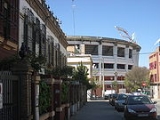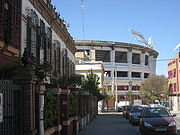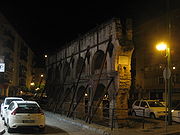
Nervión, Seville
Encyclopedia
Nervión is a large, modern neighborhood in the eastern zone of Seville
, Spain
. The neighborhood is an important commercial district of the city, where much of the regional capital's business takes place. The population is 16,129 inhabitants. It is the second focal point of the city, and is home to a number of important sites:
The Facultad de Ciencias Económicas y Empresariales (School of Business) of the University of Seville
is located in this neighborhood.
The Seville Metro
has four stations in the neighborhood: Prado, San Bernardo, Nervión and Gran Plaza. All of these are on Line 1, which became operational on 2 April 2009. The Prado station also connects to the planned Line 3, as well as the city's primary short-distance bus hub.
Many TUSSAM bus routes connect Nervión with other neighborhoods, as well as internally. These include circular lines such as the C1/C2 in addition to a number of other lines, such as the 27, that connect it with the historical center.
 Prior to 1911, most of Nervión was cultivated land, especially for the purposes of cotton growth. The land was owned by the Marques of Nervión, who donated it to the city. A few structures did exist in the zone, however, including a penitentiary, Sevilla 1, which still stands, albeit out of use and in the process of historical renovation. The remains of Roman aqueducts that brought water in from the hills of Carmona
Prior to 1911, most of Nervión was cultivated land, especially for the purposes of cotton growth. The land was owned by the Marques of Nervión, who donated it to the city. A few structures did exist in the zone, however, including a penitentiary, Sevilla 1, which still stands, albeit out of use and in the process of historical renovation. The remains of Roman aqueducts that brought water in from the hills of Carmona
were, and still are, to be found in the area.
Development of Nervión began in 1911, comprising what was then an outskirt of the city with plans centering around the Gran Plaza. The architect in charge of the planning and development was renowned Spanish architect Anibal Gonzalez, who designed many other famous structures in Seville and the rest of Andalusia
.
In the 1920s and 1930s, many low level villa style houses surrounded by gardens were built in the area. Large high-rise apartment buildings were built in the 1960s. Since the 1980s and 1990s, construction has been mainly of hotels, shopping centers and office buildings.
Seville
Seville is the artistic, historic, cultural, and financial capital of southern Spain. It is the capital of the autonomous community of Andalusia and of the province of Seville. It is situated on the plain of the River Guadalquivir, with an average elevation of above sea level...
, Spain
Spain
Spain , officially the Kingdom of Spain languages]] under the European Charter for Regional or Minority Languages. In each of these, Spain's official name is as follows:;;;;;;), is a country and member state of the European Union located in southwestern Europe on the Iberian Peninsula...
. The neighborhood is an important commercial district of the city, where much of the regional capital's business takes place. The population is 16,129 inhabitants. It is the second focal point of the city, and is home to a number of important sites:

- Santa Justa, Seville's major train station, with high-speed links via the AVEAVEAlta Velocidad Española is a service of high-speed rail in Spain operated by Renfe, the Spanish national railway company, at speeds of up to . The name is literally translated from Spanish as "Spanish High Speed", but also a play on the word , meaning "bird".AVE trains run on a network of...
to MadridMadridMadrid is the capital and largest city of Spain. The population of the city is roughly 3.3 million and the entire population of the Madrid metropolitan area is calculated to be 6.271 million. It is the third largest city in the European Union, after London and Berlin, and its metropolitan...
, CórdobaCórdoba, Spain-History:The first trace of human presence in the area are remains of a Neanderthal Man, dating to c. 32,000 BC. In the 8th century BC, during the ancient Tartessos period, a pre-urban settlement existed. The population gradually learned copper and silver metallurgy...
, and CadizCádizCadiz is a city and port in southwestern Spain. It is the capital of the homonymous province, one of eight which make up the autonomous community of Andalusia....
. - Estadio Ramón Sánchez PizjuánEstadio Ramón Sánchez PizjuánEstadio Ramón Sánchez Pizjuán is a stadium in Seville, Spain. It is the home stadium of Sevilla Fútbol Club. It was the venue for the 1986 European Cup Final between Steaua Bucureşti and Barcelona and the 1982 World Cup semi-final game between Germany and France.This stadium contains a singular...
, home to Sevilla FCSevilla FCSevilla Fútbol Club S.A.D. is a Spanish professional football club based in Seville, Spain that plays in the Spanish La Liga championship.They are one of the most successful clubs in Spanish football having won a 1 La Liga title, 5 Spanish "Copa del Rey" Cups, 1 Spanish Super Cup and 2 UEFA...
, one of Seville's two top-level soccer teams and the only one currently in the top flight of La LigaLa LigaThe Primera División of the Liga Nacional de Fútbol Profesional , commonly known as La Liga or, for sponsorship reasons, Liga BBVA since 2008, is the top professional association football division of the Spanish football league system...
. The area's name is the origin of one of Sevilla FC's nickname Los Nervionenses. - Nervión Plaza, a commercial shopping complex with many chain stores and a large movie theater with 20 screens.
- El Prado, a gardened zone that serves as a major short-distance bus hub.
- Estación de Cadiz, the lesser of the city's two trains stations. It currently serves as a fresh produce market.
The Facultad de Ciencias Económicas y Empresariales (School of Business) of the University of Seville
University of Seville
The Universidad de Sevilla or University of Seville, in English, is a top-ranked European university in Seville, Spain. Founded under the name of Colegio Santa María de Jesús in 1505, the University of Seville, with a student body of over 50,000, is one of the top-ranked universities in the country...
is located in this neighborhood.
The Seville Metro
Seville metro
The Seville metro is a light metro network serving the city of Seville, Spain and its metropolitan area. The system is totally independent of any other rail or street traffic. All stations were built with platform screen doors....
has four stations in the neighborhood: Prado, San Bernardo, Nervión and Gran Plaza. All of these are on Line 1, which became operational on 2 April 2009. The Prado station also connects to the planned Line 3, as well as the city's primary short-distance bus hub.
Many TUSSAM bus routes connect Nervión with other neighborhoods, as well as internally. These include circular lines such as the C1/C2 in addition to a number of other lines, such as the 27, that connect it with the historical center.
History

Carmona
Carmona may be:Places* Carmona, a town in Seville, Spain.* Carmona, Cavite, a municipality in the Philippines* Carmona, Goa* Carmona, Costa Rica, a city in Guanacaste province.* The former name of the Angolan town of Uíge.People...
were, and still are, to be found in the area.
Development of Nervión began in 1911, comprising what was then an outskirt of the city with plans centering around the Gran Plaza. The architect in charge of the planning and development was renowned Spanish architect Anibal Gonzalez, who designed many other famous structures in Seville and the rest of Andalusia
Andalusia
Andalusia is the most populous and the second largest in area of the autonomous communities of Spain. The Andalusian autonomous community is officially recognised as a nationality of Spain. The territory is divided into eight provinces: Huelva, Seville, Cádiz, Córdoba, Málaga, Jaén, Granada and...
.
In the 1920s and 1930s, many low level villa style houses surrounded by gardens were built in the area. Large high-rise apartment buildings were built in the 1960s. Since the 1980s and 1990s, construction has been mainly of hotels, shopping centers and office buildings.

